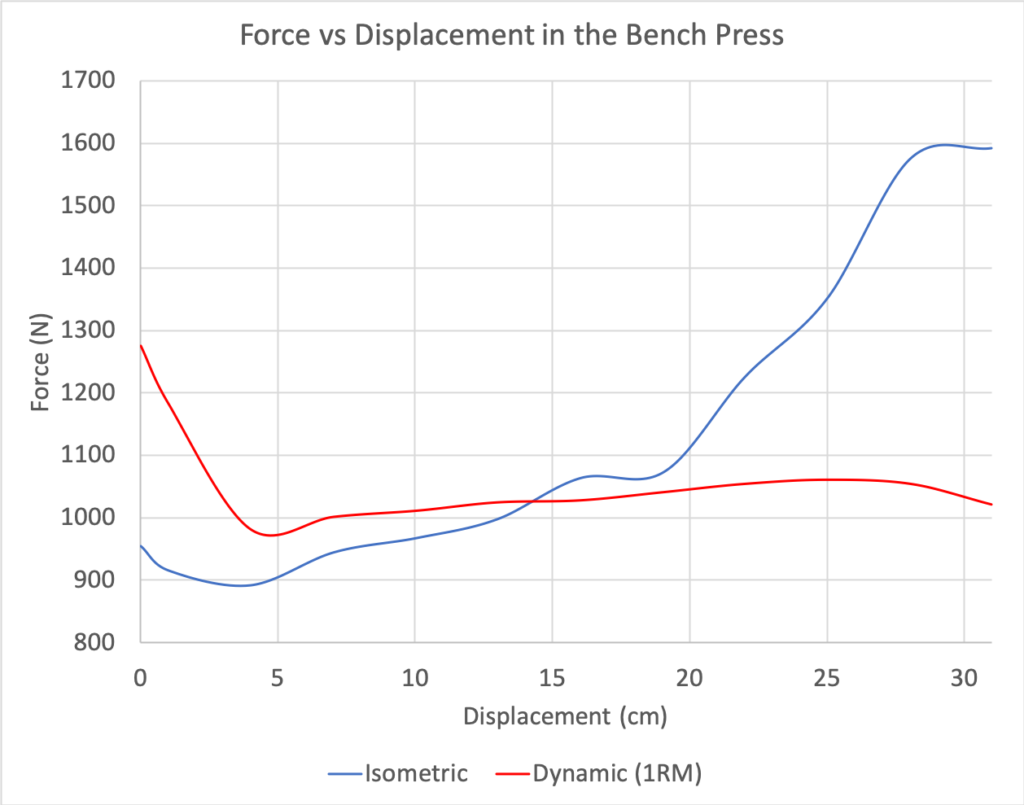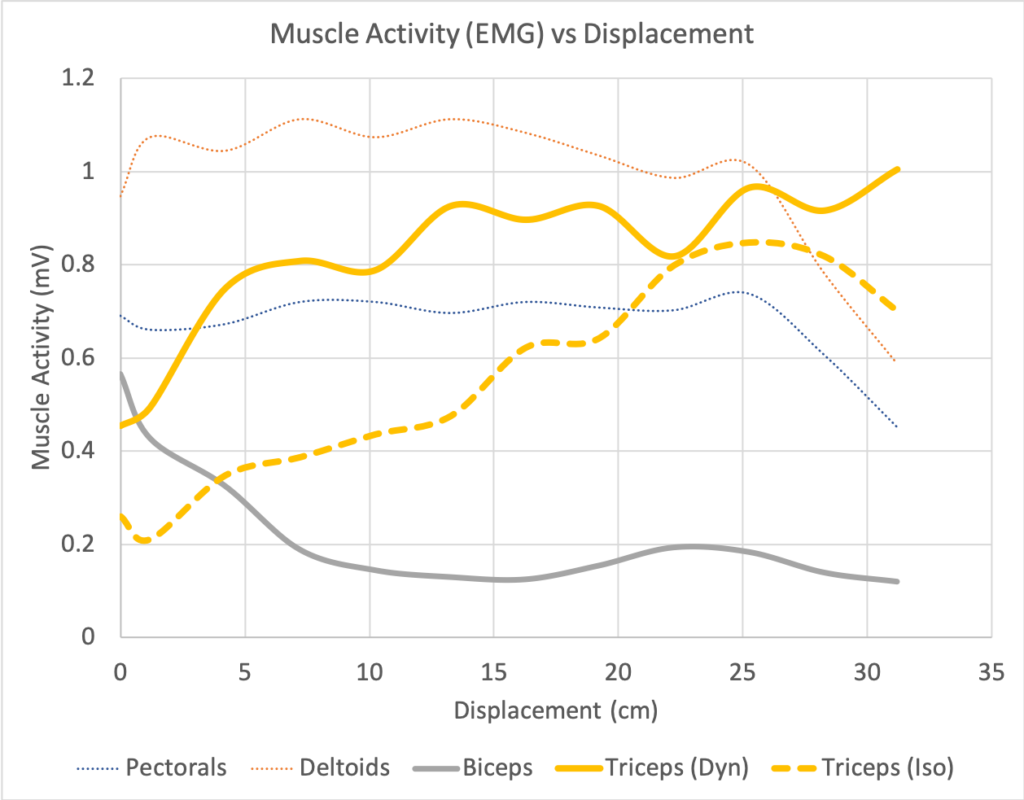Examining the different forces exerted against the barbell from chest to lockout can give us some important training insights.
Key Points
- Triceps probably aren’t your weakness
- Pauses are good. So is touch and go.
- Work on your arch.
- The jury is still out on bands & chains.
If you surveyed the powerlifting community and asked about sticking points in the bench press you’d get a lot of different responses. Some would interchange references to the sticking point and point of failure while others might misattribute why some solutions seem to be effective. There’s a good reason for the uncertainty. Even sports scientists are still looking into the issue and probing the nature of the sticking point for insights.
Tillaar, Saeterbakken, & Ettema (2012) were one such group looking for answers. Let’s take a look at where they were coming from, what they found, and what that means for us.
Study Reviewed: Is the occurrence of the sticking region the result of diminishing potentiation in bench press?
When performing a bench press near the point of failure, a sticking point is observed on the way up shortly after leaving the chest area. This point is often considered the determinant in whether or not the lift is successful. That makes studying what’s going on around the sticking point of great interest to anyone who wants to lift more weight. Unfortunately, a precise understanding of the origin of the sticking point, that is, what causes it, is not fully understood.
Attempts to understand the sticking point have looked at moment arms at the shoulders and elbows as well as changes in muscular electrical activity across the range of motion. Another possible explanation for the sticking point is a diminishment of potentiation (force gained when an eccentric contraction immediately precedes a concentric contraction ). Since pauses of varying lengths can lead to different degrees of relaxation of the elastic components in the muscle, the resulting loss of potentiation could be a cause for the sticking point.
Since potentiation is not possible in isometric contractions (due to lack of eccentric or concentric motion), the authors decided to investigate if a sticking point might also exist when isometric strength was measured incrementally across the full range of motion. In other words, test isometric strength at the chest, then 3cm off the chest, then 3cm higher, and so on. If a sticking point was also present in the overall isometric strength curve, that would rule out potentiation and suggest a poor mechanical force position is the cause.
Experimental Setup
1RM Tests
The authors recruited 12 male university students with at least one year of training experience. Prior to 1RM tests, the subjects first spent 10 minutes warming up on an exercise bike. After that, they did 4 warm-up sets with the bar using progressively heavier weights and lower reps. Subjects had 3 attempts to find a true 1RM. If a 1RM attempt was successful, another attempt was made with an additional 2.5kg on the bar after a 5-minute rest.
Isometric Tests
Ten minutes after the 1RM was established, subjects tested isometric strength at 12 different positions (in random order) along the concentric range of motion in 3 cm increments. Additionally, the authors made sure the horizontal distance between the bar and shoulder for the isometric tests matched the bar path during the 1RM attempts.
Muscle EMG Recordings
To see if there were any associations between muscle activity and force output along the range of motion, the authors aligned electrodes with the direction of the muscle fibers over the muscle bellies of the pectorals, anterior deltoids, triceps, and biceps.
Findings
Typical bench press 1RMs were around 105kg with an average velocity of 0.17m/s. The authors observed a sticking region in all 1RM attempts. Importantly, the force vs displacement curves for both 1RM attempts and isometric strength curves both showed force minimums at the same point — around 4 cm off the chest. The point where velocity reached its minimum occurred around 13 cm.

Muscle activity profiles across the range of motion showed fairly constant activities for both pectorals and deltoids. Biceps and triceps, however, swap places with both reaching approximately half-maximums around the sticking point. No significant differences were seen between muscle activities in the dynamic and isometric conditions with the exception of the triceps.

Study Conclusion
Both isometric and dynamic force curves present force minimums around the same point. This indicates the sticking point is likely due to a mechanically disadvantageous position and not caused by a diminishment of potentiation.
Deeper Analysis
Sticking Point vs Failure Point
The first thing that probably needs to be said is that the sticking point, defined as the region of lowest force output (~4 cm Fmin) is not the same as the region of the lowest barbell velocity (~ 13 cm Vmin). When you fail a lift — meaning the barbell velocity reaches 0 and turns negative — this all happens beyond the point where you are weakest. In other words, where the bar stops is not the weakest point. It occurred before that.
Triceps Fatigue?
Interestingly, the isometric force profile showed a large increase in force output after the Vmin around 13 cm. Meanwhile, dynamic force remained relatively flat and significantly lower along the same points. The question is why such a large difference? It’s possible that in the 1RM tests the bar is already in motion and no additional force is needed to complete the lift. EMG activity would suggest this is not the case as there was no reduction in activity in the dynamic 1RM tests. However, Pinto et. al., (2013) examined muscle activity at several different intensities in the bench press and found near-maximal activity is reached around 80% of 1RM. It is therefore likely that it would not be possible to observe a reduction in effort between isometric and dynamic tests based on EMG alone. So it’s possible they just aren’t trying as hard after the Vmin.
Another possible explanation for the discrepancy in the post-Vmin region is a reduction in force output due to fatigue, despite maximal effort. Isometric force data were gathered with rest intervals between the various points in the range of motion. The dynamic force profiles, however, were obtained in one continuous movement with no rest possible along the range of motion.
Moreover, the observation of triceps muscle activity reaching an earlier peak in the dynamic 1RM tests as compared to the isometric tests (~13 cm vs ~25cm) suggests triceps fatigue is significant in the upper range of motion since overall force output still remains suppressed post-Vmin despite the earlier peak in activity.
Stretch Reflex Potentiation
The dynamic 1RM tests showed a large increase in initial force output compared with the isometric tests. This initial force boost is due to stored elastic energy in various muscle components. Pausing a bench press on the chest will dissipate this stored elastic energy. The longer the pause, the more significant the reduction. Total dissipation, however, should yield an initial dynamic force profile similar to the isometric pre-sticking region.
Take-Home Points
Triceps
Be aware of triceps’ susceptibility to fatigue. If you’re having trouble with the upper range of motion it’s probably not weak triceps. The force potential is there–in excess. Instead, the problem is more likely fatigued triceps. Note that fatigue is cumulative as well and could be carried over from prior training. Recommendation for triceps accessories: if you do use targeted triceps work use low fatigue protocols (e.g., heavy weighted dips not done to failure). Also, note that a misdiagnosis of weak triceps would still yield the same recommendation.
Off the Chest
Using pauses of various lengths allows you to tune how much contribution you get from elastic and contractile components of the muscle. Use touch and go for maximum elastic potentiation, long pauses (~5 s) to totally remove potentiation and focus on contractile components, or some intermediate pause duration for a mix of both. Recommendation: pauses are good and so is touch and go. Use both and not only one. Just don’t bounce the bar off the chest. The elastic contribution should not come from your rib cage!
Range of Motion
Since the occurrence of the sticking point is most likely due to a mechanically disadvantageous position early in the lift, reducing the range of motion will shift the region of potentiation higher. This could allow you to skip over the sticking point to some degree. Recommendation: improve your arch and use the widest grip you can.
Sticking Point
You’re probably not going to eliminate the sticking point by trying to increase force output there with isometrics. Dynamic strength there already exceeds isometric strength. But don’t dismiss pauses at the sticking point yet. They can still be useful for increasing your coordination and overall body positioning as well as bar path optimization at a critical point. Recommendation: make sure you’re proficient in holding the bar at the sticking point.
Bands & Chains?
We could theoretically match the isometric strength curve to a greater degree with accommodating resistance. But it’s not clear that would have the desired training effect. Recommendation: find a better reason to use accommodating resistance. They might still have benefits elsewhere.